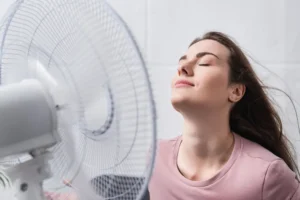Is your bathroom constantly damp, kitchen filled with smoke, or rooms smelling stale?
Poor ventilation can create uncomfortable living conditions and even health issues at home.
Exhaust fans effectively remove stale air, moisture, smoke, odours, and pollutants, significantly improving indoor air quality.
The main types include:
- Ceiling Exhaust Fan: These fans are installed in rooms that lack direct access to outdoor spaces. Stale air is channelled through a duct in the ceiling.
- Wall-Mounted Exhaust Fan: This is the most popular type used in homes. Installed on walls facing open areas, these types of exhaust fans effectively remove smoke, steam, and unpleasant odours without the need for exhaust ducts.
- In-line Exhaust Fan: These fans are known for their power and aesthetic elevation by adding a minimal and clean look to the room. They are mounted inside or connected to ducting.
- Window Exhaust Fan: Designed to fit neatly into windows, these fans typically have compact dimensions and sleek designs to ensure easy installation and a seamless look.
- Rangehood Exhaust Fan: Installed above kitchen stoves, these fans remove smoke, steam, grease, and cooking odours, significantly improving kitchen air quality.
- Exterior Exhaust Fan: Mounted outside the home, these fans reduce indoor noise while effectively removing stale air and moisture from inside spaces.
To fully understand the types of exhaust fans available and choose the best one for your home, keep reading.
What is a Ceiling Exhaust Fan?
Have you ever stepped out of the shower into a damp, uncomfortable bathroom?
Poor ventilation could be ruining your daily routine.
A ceiling exhaust fan is typically installed in ceilings and connected to ducts, removing stale air, humidity, and odours by directing them outside.
They’re commonly used in bathrooms lacking direct outdoor ventilation.

How Does a Ceiling Exhaust Fan Work?
Ceiling exhaust fans pull stale air upward into an attached duct system hidden in the ceiling.
These ducts carry humid air, smells, and pollutants directly outside.
This helps prevent moisture buildup, mould, and bacteria growth in your bathroom or any room without direct outside access.
These fans may also come with additional features like built-in lights or heating elements.
Installing a ceiling exhaust fan with these options helps maintain comfort, especially during winter or in rooms with limited lighting.
Here’s a quick overview of where and why ceiling exhaust fans are beneficial:
| Room | Main Benefit | Additional Features |
|---|---|---|
| Bathroom | Prevents mould, removes steam | Built-in lights, heaters |
| Laundry | Removes humidity | Quiet operation |
| Storage | Improves ventilation | Automatic shutters |
Choosing the Right Ceiling Exhaust Fan
To choose the right fan, you must consider room size and fan capacity.
Ceiling exhaust fans are measured by airflow capacity, usually in cubic metres per hour (m³/hr).
Here’s a basic guide for selecting fan sizes:
| Room Size (sqm) | Required Airflow (m³/hr) |
|---|---|
| 10-20 | 85-170 |
| 20-30 | 170-255 |
| 30-40 | 255-340 |
For optimal performance, pick a fan that slightly exceeds your room’s requirements.
Ceiling exhaust fans are essential, especially in bathrooms, to maintain comfort and health.
What is a Wall-Mounted Exhaust Fan?
Do you struggle with smoke or unpleasant odours, especially in areas with limited ceiling space?
Not installing an appropriate fan might leave your home unhealthy.
Wall-mounted exhaust fans directly remove pollutants, smoke, steam, and smells by expelling air through walls adjacent to open spaces.
They don’t require extensive ducting, making them ideal for tight spaces.

Why Choose a Wall-Mounted Exhaust Fan?
Wall-mounted fans are perfect for kitchens, laundries, and bathrooms where ceilings are inaccessible or too narrow for duct installation.
They effectively remove pollutants directly outdoors without complicated duct systems.
They’re easier and cheaper to install compared to ceiling fans because they require no extensive ducting.
Wall-mounted fans are available in various sizes to match the size of your room and your ventilation requirements.
Considerations Before Installing Wall-Mounted Fans
When choosing a wall-mounted fan, think about the following points:
- Room size and airflow required (m³/hr)
- The thickness of the wall (ensure compatibility)
- The noise level produced by the fan
- Additional features such as automatic shutters or bird screens
These aspects significantly impact efficiency and usability.
To illustrate, here’s a simple selection chart:
| Room Type | Recommended Airflow (m³/hr) |
|---|---|
| Small Bath | 85-100 |
| Kitchen | 200-300 |
| Laundry | 100-150 |
Installing the correct wall-mounted fan improves your home’s air quality significantly.
What is an Inline Exhaust Fan?
Does your home have larger spaces or multiple rooms needing ventilation?
Using standard exhaust fans might not be efficient enough.
Inline exhaust fans are powerful ventilation systems installed within ductwork, typically hidden in ceilings.
They efficiently extract moisture, heat, and stale air from larger spaces or multiple rooms simultaneously.

Benefits of Inline Exhaust Fans
Inline fans are energy-efficient and powerful.
They’re perfect for ventilating large spaces, such as commercial buildings, or multiple rooms connected through ducts.
They operate quietly, as the motor is located away from the living space.
Here are the key advantages of inline exhaust fans:
- Quiet operation due to remote motor location
- Powerful extraction capacity suitable for large spaces
- Versatile installation options within duct systems
- Can support multiple extraction points in different rooms
Applications for Inline Fans
Inline fans work best in the following scenarios:
| Application | Reason for Use |
|---|---|
| Large bathrooms | Efficient moisture removal |
| Kitchens with long ducting | Powerful smoke extraction |
| Multiple connected rooms | Centralized ventilation |
| Commercial buildings | Effective air control and ventilation |
Consider an inline fan if you need consistent, quiet, and powerful ventilation across larger or multiple spaces.
What is a Window Exhaust Fan?
Struggling with limited wall or ceiling options for ventilation?
The lack of proper airflow might be creating discomfort.
Window exhaust fans fit directly into window spaces, effectively removing stale air, moisture, and odours.
They often feature reversible airflow, multiple speed settings, and built-in thermostats for efficient ventilation.

Advantages of Window Exhaust Fans
Window exhaust fans are compact and simple to install.
They are perfect for apartments or homes without room for ceiling or wall installations.
Many models allow reversible airflow, letting you draw fresh air in or push stale air out as needed.
When Should You Choose a Window Exhaust Fan?
Here’s when window exhaust fans become especially useful:
- Apartments or rental homes with installation restrictions
- Rooms lacking wall or ceiling space
- Small kitchens or bathrooms needing frequent ventilation
- Rooms needing temperature-controlled ventilation
These fans typically feature thermostatic control, shutting off automatically once desired temperatures are reached.
This adds energy efficiency and convenience.
What is a Rangehood Exhaust Fan?
Do cooking smells, smoke, and grease build up in your kitchen?
Without proper ventilation, cooking can become uncomfortable and unhealthy.
Rangehood exhaust fans, mounted above stoves, remove smoke, steam, grease, and odours directly from cooking areas.
They significantly enhance indoor air quality, making kitchens safer and more pleasant.

Types of Rangehood Exhaust Fans
Rangehoods come in two types:
| Type | Ducting Required | Efficiency |
|---|---|---|
| Ducted | Yes | High efficiency |
| Recirculating | No | Moderate efficiency |
Ducted rangehoods expel air outside directly, offering better performance.
Recirculating fans use filters to clean air and circulate it back, requiring less installation effort.
Maintenance for Rangehood Fans
To maintain peak efficiency, regularly clean or replace filters in your rangehood exhaust fans.
Filters clogged with grease or dirt significantly reduce fan effectiveness and can pose fire hazards.
What is an Exterior Exhaust Fan?
Annoyed by the noise from your indoor exhaust fans?
Noisy fans disturb your peace at home.
Exterior exhaust fans are installed outside your home, pulling stale indoor air outward, significantly reducing indoor noise.
They’re ideal for quiet, effective ventilation in noise-sensitive areas.

Benefits and Limitations
| Benefits | Limitations |
|---|---|
| Quiet indoor environment | Installation complexity |
| Powerful airflow | Higher upfront cost |
| Ideal for bedrooms and offices | Regular outdoor maintenance required |
Exterior fans provide comfort through quiet operation but may require more effort and investment initially.
Conclusion
Selecting the right exhaust fan ensures fresh, healthy indoor air, reducing moisture, odours, and pollutants throughout your home efficiently.
Choose wisely to enhance your living spaces.
FAQ
What is the difference between axial and centrifugal exhaust fans?
Axial fans move air parallel to the fan’s axis and are suitable for high airflow with low pressure, commonly used for general ventilation.
Centrifugal fans, however, move air perpendicular to the intake, providing higher pressure, making them ideal for applications requiring air movement through ducts.
Can I install an exhaust fan in a room without exterior walls or windows?
Yes, you can install a ceiling-mounted exhaust fan connected to ductwork that channels air to the exterior, suitable for rooms lacking direct outdoor access.
How do I determine the appropriate size of an exhaust fan for my room?
To determine the correct size, calculate the room’s volume (length × width × height) in cubic feet.
Then, select a fan with a CFM (Cubic Feet per Minute) rating that matches or exceeds this volume to ensure proper ventilation.
Are there exhaust fans designed for high-humidity areas like saunas or hot tubs?
Yes, for high-humidity areas, it’s recommended to use exhaust fans with high CFM ratings to effectively remove moisture and prevent mold growth.
Can I use the same exhaust fan for my kitchen and bathroom?
It’s advisable to use separate exhaust fans for kitchens and bathrooms due to differing ventilation needs.
Kitchen exhaust fans are designed to handle grease and cooking odors, while bathroom fans focus on removing moisture.
What maintenance is required for exhaust fans?
Clean the fan every six months.
Regular maintenance includes cleaning the fan blades and grills to prevent dust buildup, checking and replacing filters if applicable, and ensuring that the ductwork is free from obstructions to maintain optimal performance.
Can exhaust fans help reduce indoor pollutants?
Yes, exhaust fans can help reduce indoor pollutants by removing stale air, odors, and airborne particles, thereby improving indoor air quality.
Is it necessary to vent exhaust fans to the outside?
Yes, it’s essential to vent exhaust fans to the outside to prevent moisture buildup, which can lead to mold growth and structural damage.
Can I install an exhaust fan myself, or should I hire a professional?
While some exhaust fans are designed for DIY installation, it’s recommended to hire a professional, especially if electrical work or duct installation is required, to ensure safety and compliance with local building codes.


